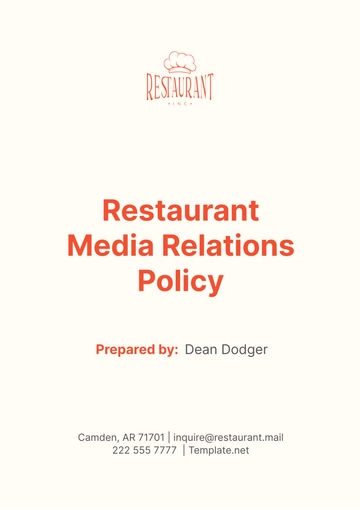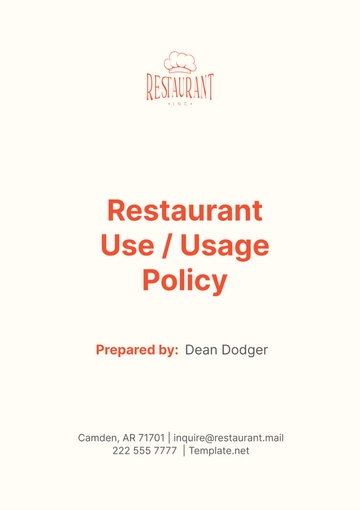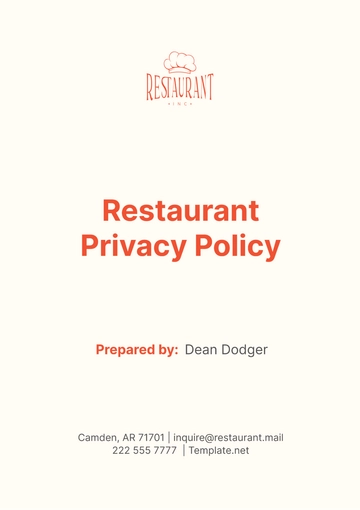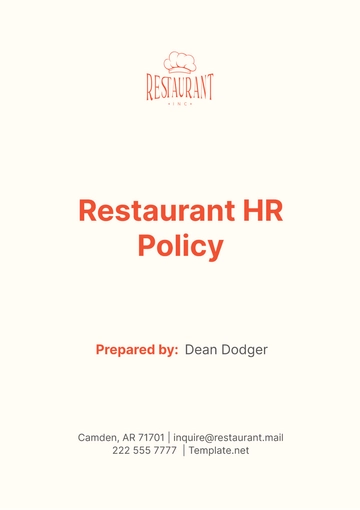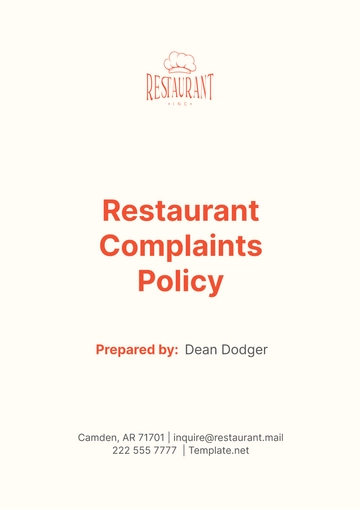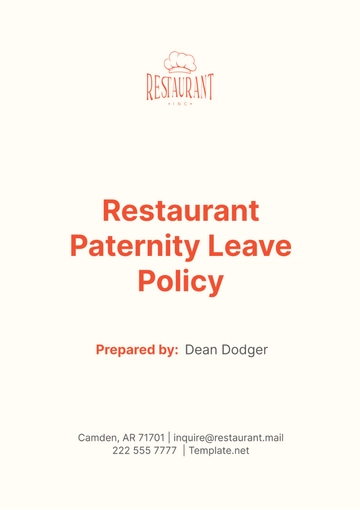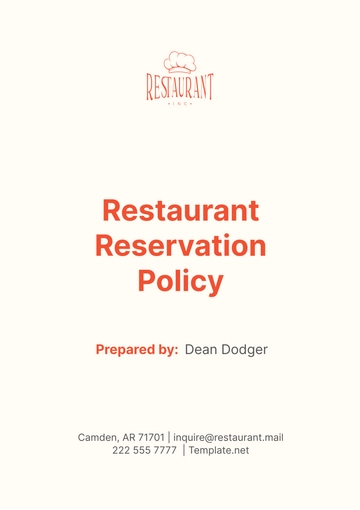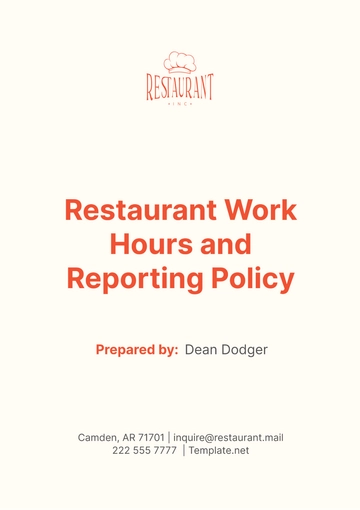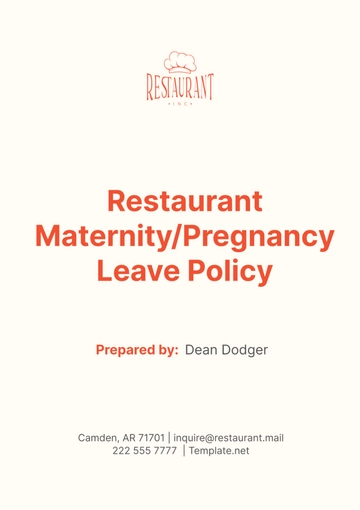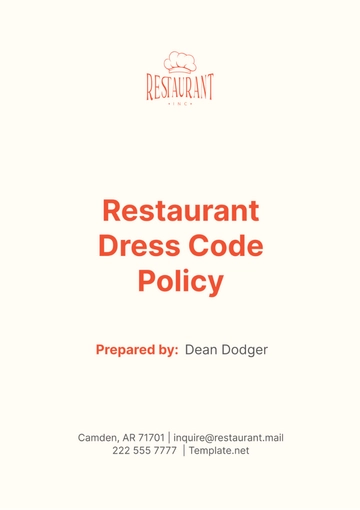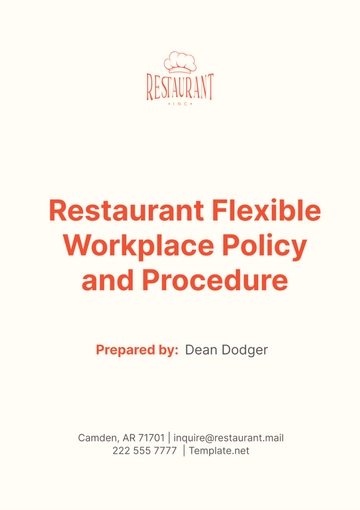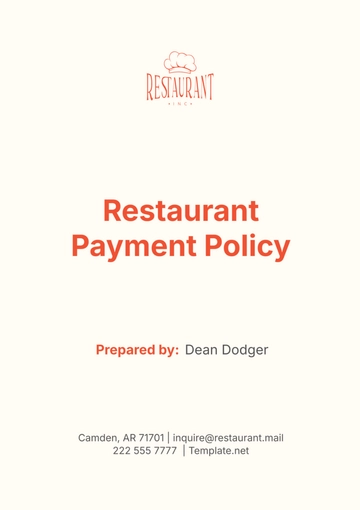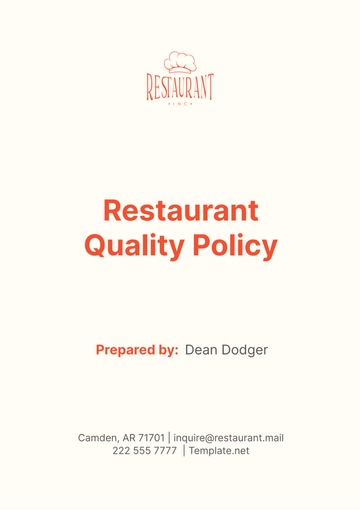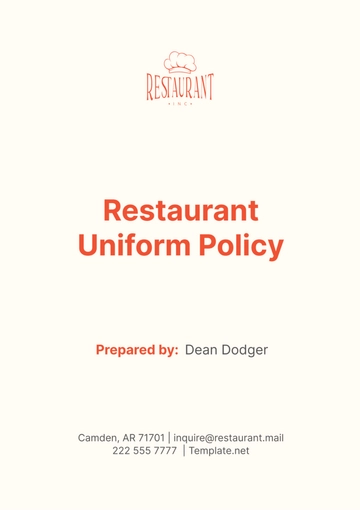Free Restaurant Paternity Leave Policy

I. Introduction
A. Purpose of the Policy
The Restaurant Paternity Leave Policy aims to acknowledge the importance of fatherhood and provide support to new fathers within our organization. By offering paternity leave, we aim to promote gender equality, foster employee well-being, and strengthen family bonds.
B. Scope and Applicability
This policy applies to all employees of [Your Company Name], including full-time, part-time, and temporary employees, regardless of their position or tenure with the company. It covers paternity leave for biological fathers, adoptive fathers, and employees assuming legal guardianship of a child.
C. Commitment to Work-Life Balance
At [Your Company Name], we are committed to promoting work-life balance and recognize that supporting employees in their roles as parents contributes to a positive work environment. We believe that offering paternity leave is essential in creating a supportive culture that values both professional and personal responsibilities.
II. Eligibility
A. Employees Covered
All employees of [Your Company Name] who are hired on a regular full-time basis, as well as those who serve in part-time capacities, are entitled to avail themselves of the paternity leave benefits delineated in this policy. This entitlement is inclusive of and extends to all staff members irrespective of their gender identity, their marital status, or their sexual orientation.
B. Length of Service Requirement
Employees must have worked continuously for the company for at least [0] months prior to the anticipated birth or adoption placement to qualify for paternity leave.
C. Definition of "New Father"
A "new father" is defined as an employee who becomes a biological or adoptive father, or assumes legal guardianship of a child, and intends to take leave for the purpose of bonding with the child or supporting the child's primary caregiver.
III. Entitlement to Paternity Leave
A. Duration of Leave
Eligible employees are entitled to up to [0] weeks of paternity leave, providing them with adequate time to bond with their newborn or newly adopted child and support their family during the initial stages of parenthood.
B. Paid vs. Unpaid Leave
Paternity leave is generally unpaid, but employees may use accrued paid time off (such as vacation or sick leave) during their absence, in accordance with company policy and applicable laws.
C. Interaction with Other Leave Policies
Paternity leave may run concurrently with other types of leave, such as Family and Medical Leave Act (FMLA) leave, state-mandated leave, or company-specific leave policies, where applicable and as permitted by law.
IV. Requesting Paternity Leave
A. Notice Requirements
Employees are required to provide [0] weeks' advance notice of their intention to take paternity leave, except in cases of unforeseeable circumstances, such as premature birth or sudden adoption placements.
B. Documentation Required
To request paternity leave, employees must submit a formal request to their supervisor or the HR department, accompanied by supporting documentation, such as a birth certificate or adoption papers.
C. Process for Requesting Leave
The request for paternity leave should be made using the designated leave request form, available from the HR department or company intranet. Supervisors and HR personnel will review and approve leave requests in accordance with company policy and applicable laws.
D. Designation of Leave
[Your Company Name] reserves the right to designate an employee's absence as paternity leave under this policy, based on the information provided by the employee and in compliance with relevant laws and regulations.
V. Benefits and Protections During Paternity Leave
A. Maintenance of Benefits
During paternity leave, employees will continue to be eligible for certain employment benefits, such as health insurance coverage and retirement contributions, in accordance with applicable laws and company policies.
B. Job Protection
Employees who take paternity leave are guaranteed job protection and the right to return to their same or equivalent position upon their return to work, as mandated by law and company policy.
C. Return to Work Arrangements
To facilitate a smooth transition back to work, employees should communicate with their supervisor or the HR department regarding their expected return date and any necessary accommodations or arrangements.
VI. Flexibility and Intermittent Leave
A. Flexibility in Scheduling Leave
[Your Company Name] recognizes that employees may require flexibility in scheduling their paternity leave to meet their personal and family needs. Supervisors will work collaboratively with employees to accommodate reasonable requests for leave scheduling, subject to operational requirements.
B. Intermittent Leave Options
Employees may request intermittent paternity leave, allowing them to take leave in separate blocks of time rather than all at once. Approval of intermittent leave will be granted based on the employee's needs and the operational needs of the restaurant.
C. Approval Process for Intermittent Leave
Requests for intermittent paternity leave should be submitted in writing to the employee's supervisor or the HR department, outlining the specific dates and duration of leave requested. Approval will be granted based on the needs of the employee and the operational requirements of the restaurant.
VII. Communication and Confidentiality
A. Communication Expectations
Open and honest communication between employees and management is essential during the paternity leave process. Employees are encouraged to notify their supervisor or the HR department as soon as possible regarding their intention to take leave and to provide updates as needed.
B. Confidentiality of Personal Information
[Your Company Name] is committed to maintaining the confidentiality of employees' personal information related to paternity leave. All information provided by employees will be treated with the utmost confidentiality and shared only on a need-to-know basis, in compliance with applicable laws and regulations.
VIII. Support Resources
A. Employee Assistance Programs (EAP)
Employees may have access to confidential counseling services through the company's Employee Assistance Program (EAP), which can provide support and guidance during times of transition or personal challenges related to parenthood.
B. Referral to Support Services
[Your Company Name] may provide information and referrals to external support services, such as parenting classes, lactation consultants, or family counseling services, to assist employees during their paternity leave and beyond.
C. Employee Support Groups
Employees may have the opportunity to participate in employee support groups or networks, where they can connect with other new fathers and share experiences, resources, and advice on balancing work and family responsibilities.
IX. Compliance with Legal Requirements
A. Compliance with Applicable Laws and Regulations
[Your Company Name] is committed to complying with all relevant federal, state, and local laws and regulations governing paternity leave, including but not limited to the Family and Medical Leave Act (FMLA), state parental leave laws, and anti-discrimination laws.
B. Monitoring and Updating Policy
This policy will be regularly reviewed and updated as necessary to ensure compliance with legal requirements and alignment with best practices in paternity leave policies. Any changes to the policy will be communicated to employees in a timely manner.
X. Implementation and Training
A. Distribution of Policy
The Restaurant Paternity Leave Policy will be distributed to all employees upon hire and made available through the company's employee handbook or intranet. New hires will receive orientation training that includes information on their rights and responsibilities related to paternity leave.
B. Training for Managers and Employees
Managers and HR personnel will receive comprehensive training on the provisions of this policy to ensure consistent implementation and effective communication with employees. Employees will also receive training on their rights and obligations under the policy during orientation and ongoing training sessions.
C. Handling of Requests and Concerns
Employees who have questions or concerns about the paternity leave policy or their entitlement to paternity leave should contact their immediate supervisor or the HR department for assistance. All inquiries will be addressed promptly and confidentially.
XI. Review and Evaluation
A. Periodic Review of Policy Effectiveness
[Your Company Name] will conduct regular reviews of the paternity leave policy to evaluate its effectiveness in meeting the needs of employees and the objectives of the company. Feedback from employees, supervisors, and HR personnel will be considered during these reviews.
B. Employee Feedback Mechanisms
Employees are encouraged to provide feedback on their experiences with paternity leave and suggestions for improvement through anonymous surveys, focus groups, or one-on-one discussions with HR representatives. Feedback will be used to identify areas for enhancement and make necessary adjustments to the policy.
C. Continuous Improvement Efforts
Based on feedback and review findings, [Your Company Name] will implement continuous improvement efforts to enhance the paternity leave policy and related practices. This may include updating procedures, providing additional support resources, or offering training to managers and employees on paternity leave-related topics.
XII. Definitions
A. Key Terms and Concepts Used in the Policy
"Paternity Leave": Time off granted to eligible employees for the purpose of bonding with a newborn or newly adopted child or supporting the child's primary caregiver.
"Intermittent Leave": Leave taken in separate blocks of time rather than all at once, subject to approval by the company.
"Eligibility Criteria": Requirements that employees must meet to qualify for paternity leave under this policy, including length of service and status as a "new father."
B. Additional Definitions
"Continuous Service": The uninterrupted period of employment with [Your Company Name] from the date of hire to the present.
"Supporting Documentation": Official documents, such as birth certificates or adoption papers, required to support a request for paternity leave.
- 100% Customizable, free editor
- Access 1 Million+ Templates, photo’s & graphics
- Download or share as a template
- Click and replace photos, graphics, text, backgrounds
- Resize, crop, AI write & more
- Access advanced editor
Manage paternity leave effortlessly with Template.net's Restaurant Paternity Leave Policy Template. This editable and customizable template, designed for seamless integration, simplifies policy creation. Use the AI Editor Tool for precise adjustments, ensuring compliance and clarity. Enhance employee satisfaction and support with this professional, easy-to-use solution tailored for the restaurant industry.
You may also like
- HR Policy
- Restaurant Policy
- Company Policy
- Accounting Policies and Procedures
- Website Policy
- Privacy Policy
- Safety Policy
- School Policy
- IT and Software Policy
- Law Firm Policy
- Construction Policy
- Interior Design Policy
- Travel Agency Policy
- Education Academic Policy
- Security Policy
- Real Estate Policy
- Expense Policy
- Software Policy

